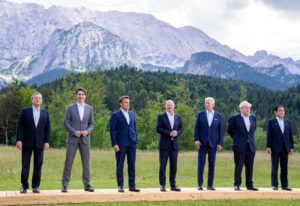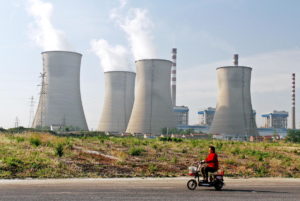One of the achievements of COP26 in Glasgow, according to a UK government statement, was that it kept alive the goal of keeping average global temperature rise within 1.5C. That this can be considered an achievement probably explains a growing sense of urgency about whether this ambitious target will be met at all. The realisation has dawned that, despite all the global agreements on climate change dating back to the Kyoto Protocol in 1997, progress on climate action is too slow, with the serious risk that the 2030 emissions targets under the Paris Agreement will be missed.
A new approach is needed to galvanise efforts and persuade all countries to play their part in fighting climate change. One idea that has quietly been building momentum over a number of years is the “climate club”. It has found favour in international policy circles, and has now gained serious political backing from German Chancellor Olaf Scholz, who is also currently chairing Germany’s G7 Presidency. In January this year, Scholz, addressing a high-powered audience at the World Economic Forum in Davos, declared: “We will use our Presidency of the G7 to turn that group into the nucleus of an International Climate Club.”
What is a climate club?
Numerous examples of climate clubs already exist, of different type and purpose, but the model developed by Nobel-prize winning economist William Nordhaus in 2015 has gained most attention. As formulated by him, such a club would operate outside the UN climate regime, and have three main features: firstly, all members would need to have comparable carbon-pricing mechanisms; secondly, non-members that fail to take action on climate change could be sanctioned; and thirdly, the benefit of the club – and the incentive to join – would be a tariff-free border between members.
The key feature of the climate club is the ability to sanction those countries that do not take action. As Nordhaus says: “It has proven difficult to induce countries to join in an international agreement with significant reductions in emissions. The fundamental reason is the strong incentives for free-riding in current international climate agreements.” He describes free-riding as when “a party receives the benefits of a public good without contributing to the costs. In the case of the international climate change policy, countries have an incentive to rely on the emissions reductions of others without taking proportionate domestic abatement.” For Nordhaus, this is “at the heart of the international failures to deal with climate change”.
Governments can sign up to agreements to meet net-zero carbon targets in a blaze of publicity, then fail to implement them for political reasons
The problem with the current system of climate change negotiations is that it is based around voluntary actions. Perhaps inevitably, the intentions are good but progress is slow. Governments can effectively sign up to agreements to meet net-zero carbon targets in a blaze of publicity, such as at last year’s COP26 summit, but then fail to implement them for political reasons. Good intentions can easily lose their way in the corridors of power, amid intense negotiations between stakeholders. An example is the EU environment committee’s decision in May to impose tough restrictions on free carbon market credits, which industry has come to rely upon to meet its carbon reduction obligations. However, after particularly intense lobbying on behalf of the energy industry, the EU parliament decided on 8 June to back a range of amendments to its reform of the EU’s carbon market, effectively watering down the ambitious proposals.
Energy security is a problem that cannot be wished away. Last year, the Japanese government baldly stated that “no compromise is acceptable to ensure energy security”. In the EU, even before Russia’s invasion of Ukraine highlighted Europe’s dependence on Russian oil and gas, and in the run up to COP26, the big debate was whether nuclear energy and fossil fuel gas can be considered green enough to qualify for EU funding. In June, China and India both announced plans to increase their domestic coal production by a combined total of 700 million tons per year to meet a surge in demand. Coal consumption will remain a central pillar of their economies for decades to come.
Rather than inviting countries to participate in multilateral negotiations on climate change, such as at the COP summits, Nordhaus believes they should be incentivised. He argues that “no individual country has an incentive to cut its emissions sharply. Moreover, if there is an international agreement, nations have a strong incentive not to participate. If they do participate, there is a further incentive to miss ambitious objectives. The outcome is a non-cooperative free-riding equilibrium in which few countries undertake strong climate change policies – a situation that closely resembles the current international policy environment. Nations speak loudly but carry the tiniest of sticks.”
Nordhaus believes that “without sanctions against non-participants, there are no stable coalitions other than those with minimal abatement. By contrast, a regime with small trade penalties on non-participants, a Climate Club, can induce a large stable coalition with high levels of abatement.”
Clubs need critical mass
A climate club, depending on how it is structured, could address a number of issues. The Ecologic Institute, an environmental think tank in Berlin, sets out several recommendations: the first is that independence from imported fossil fuels should not only be compatible with climate neutrality but must be seen as tantamount to it; second, a climate club based on minimum or uniform carbon prices remains politically elusive, technically challenging and its benefits doubtful; third, sectoral or industrial alliances have great potential; fourth is the creation of a green hydrogen alliance, based on a common market with uniform standards for green and sustainable hydrogen; and lastly, technical and financial assistance should be provided for developing countries to help them meet their climate targets.
One problem with the climate club approach is that, to be effective, it has to gain critical mass, which means the participation of the major economic players – the EU, China and the US. However, Carne Ross, associate director of geopolitics, diplomacy and security at climate change thinktank E3G, and a former British diplomat, believes the prospects for international cooperation are bleak: “The war in Ukraine is fracturing the rules-based world order. Global institutions like the UN are increasingly stymied. Divisions are deepening between the vigorous opponents of the Russian invasion in the West and those, like China and India, who are more permissive.”
To be effective, a climate club needs participation of the major economic players – the EU, China and the US
To ensure continued progress, Ross writes, “a broad international architecture of cooperation, embracing trade, development and technology will be needed: if you like, a climate world order, a system of cooperative structures, rules and alliances that will, if designed correctly, deepen ties between countries and blocs, and reweave the tattered fabric of international collaboration.” Instead of measures such as the EU’s Carbon Border Adjustment Mechanism, which is seen as a protectionist tariff by trade partners such as the US and China, he writes, “we need a new global and harmonised system of regulations, subsidies and carbon prices so that decarbonisation is maximised and disputes are minimised.”
The current diplomatic outlook may be bleak, but if the EU, China and the US share the same environmental aspirations – the health of the planet – they might find the political will to agree on terms for a climate club. Simone Tagliapietra and Guntram B Wolff of the Breugel Institute, a Brussels-based economic thinktank, point out that together they have the power to drive global climate action, as they represent 61% of global gross domestic product and 43% of goods imports, “a powerful incentive for other countries to join”.
The vision is compelling but the political reality puts some formidable obstacles in the way. Robert Falkner, research director of the Grantham Research Institute on Climate Change and the Environment at the London School of Economics, believes that of all the climate clubs around the world, the Nordhaus model is “the most far-reaching and demanding, as it requires countries to agree on legally binding rules and sanctions against rule-breakers”. However, this is also why “it is the least politically feasible”.
In particular, it is not clear yet how the Nordhaus model, beyond a group of like-minded countries, can enforce climate agreements with any more success than the UN climate summits have gained so far. As Falkner writes: “Issue complexity and interest diversity lead most major powers to reject comprehensive and binding rules. There are good reasons why international climate policy has converged around the Paris Agreement approach of combining voluntary pledges with an international review mechanism… The main appeal of the [Nordhaus] club – its policy stringency and legal strength – is the very reason why it would prove difficult to create it in the first place, and why it might unravel the existing multilateral framework for addressing climate change.”
The Nordhaus climate club, as Falkner describes it, is something of a “holy grail”. Whatever Scholz achieves, after a series of intense negotiations and compromise, it will most likely be something less ambitious and not legally binding.
A G7 statement issued on 28 June confirms that Scholz’s climate club, instead of sanctioning free-riders, will establish “an open, cooperative international Climate Club, consistent with international rules”, with a particular focus on transforming industry. Whether that will accelerate climate action remains to be seen.








